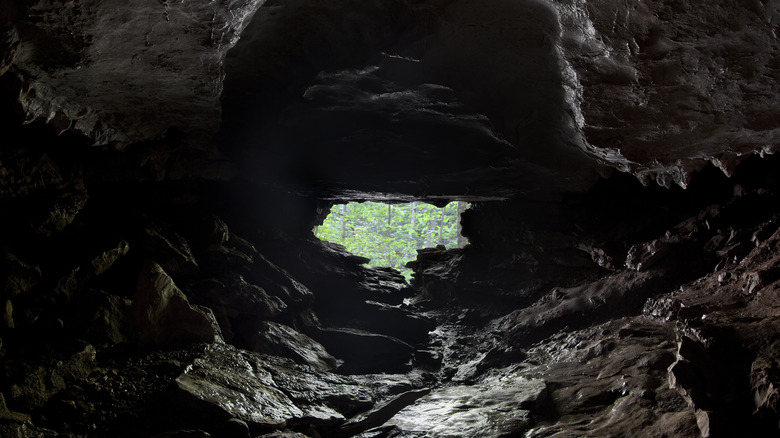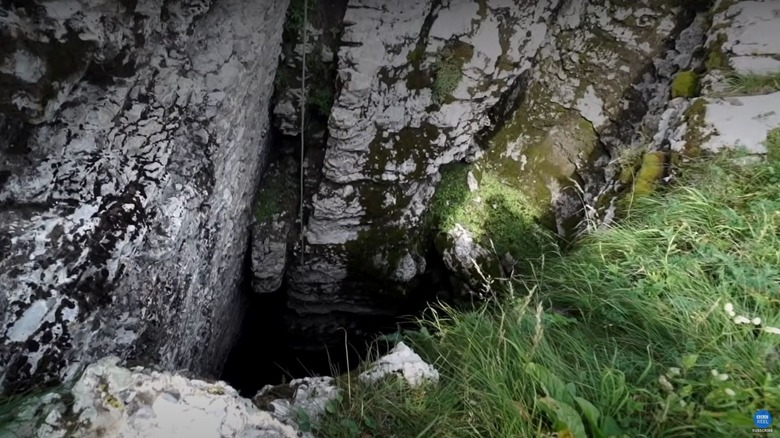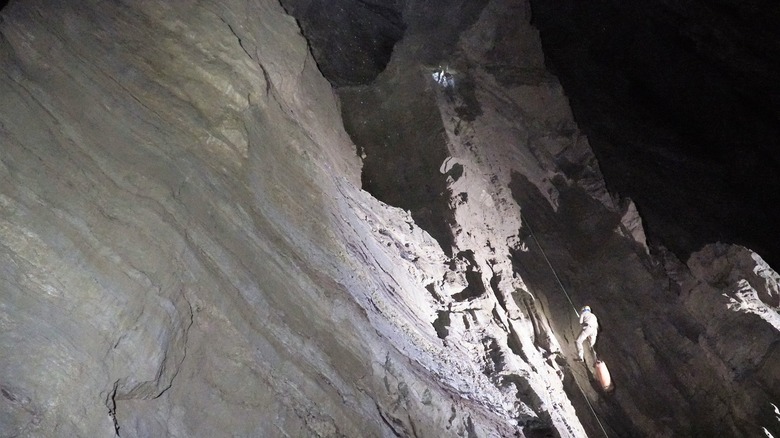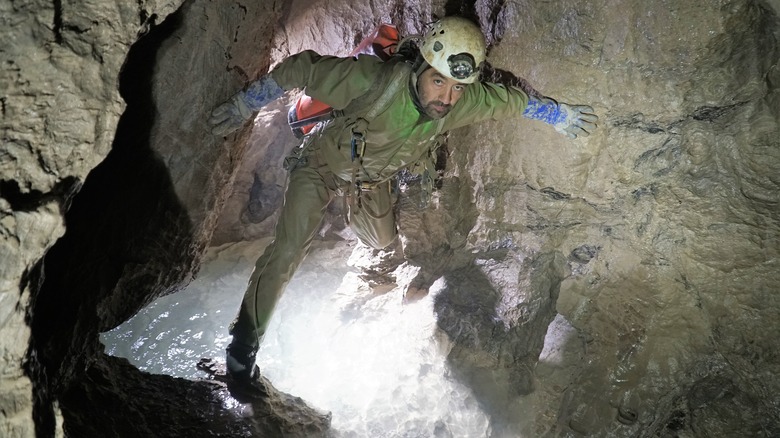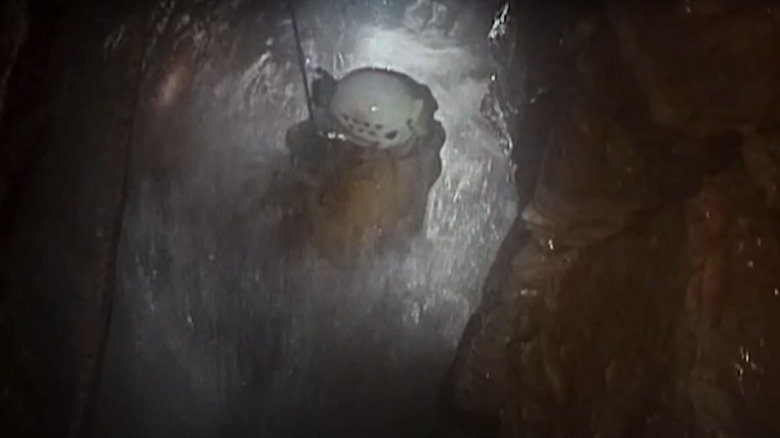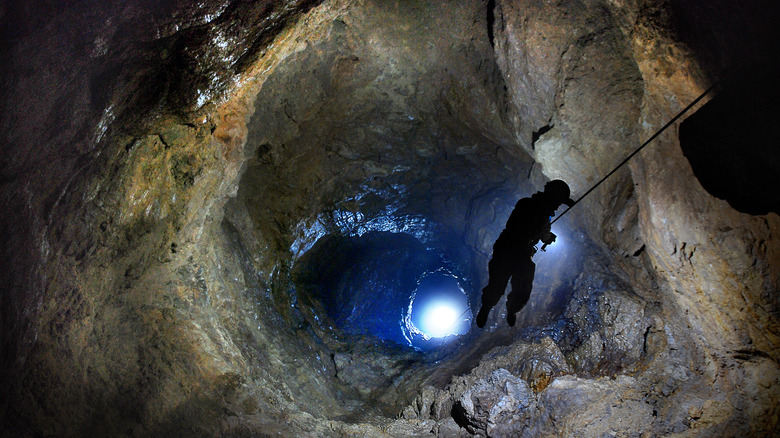The Lethal History Of The World's Deepest Cave, Veryovkina Cave
You know how some folks are driven to climb mountains? Some opt for the more leisurely, "hiking along trails to the top" kind of option. Others do full-on alpine climbing, complete with a harness and rope so they don't fall to their deaths. Some rare individuals like Alex Honnold do "free soloing," which is climbing up a rock face with only your bare hands. Just watching it will basically make your heart stop dead from anxiety – YouTube's got footage if you dare.
What about caves, then? Mountains go up, caves go down. Cave exploration — spelunking, or for scientific exploration, speleology — might not get as much attention as mountain climbing, but it's not any less daring. After all, once you go down, you've got to go back up, right? Mountains might be big, eye-catching things, but caves are subtle and mysterious. They're associated with myth and legend, even conspiracy. Ancient origins stories of indigenous peoples like the Lakota describe humanity emerging from deep within a cave, per the National Park Service. More recently, the Hollow Earth Theory is basically an extension of humanity's fascination with, and fear of, Earth's deep, dark, inner places.
If we measure mountain climbing by height, using a peak like Mt. Everest, what about caves? What's the deepest anyone's ever descended? Reach Earth's center and you'll incinerate, as Neil DeGrasse Tyson explains on TikTok. Well before that point — at about 7,257 feet down, per LatLong – you'll reach the bottom of Veryovkina Cave.
Mountain caves plunging deep
If you were walking across the gorgeous, green, mountainous landscape of the Russia-backed Georgian breakaway state Abkhazia, you might not even notice the entrance to Veryovkina Cave (above). At about 10 by 13 feet, the cave's relatively small entrance belies a massive, seemingly endless configuration of craggy passageways that pierce deeper and deeper into the limestone of Earth's crust. A map of Veryovkina Cave on WonderMondo shows how the cave wasn't explored all at once, but in stages. The first expedition in 1968 reached the Krasnoyarsk Branch, about 377 feet down, and gave Veryovkina Cave its original moniker: C-115 (115 meters deep). Just to put things in perspective: that's about as deep as the Empire State Building is tall. And that? It's only about 5% of the entire depth of Veryovkina Cave.
At this point, you might rightly wonder what would possess anyone to gaze at an unknown, rock-rimmed hole in the ground and say, "You know what? I'm gonna jump in that." At the same time, we should be glad some brave individuals are willing to do so (much more carefully than jumping), and bring back the photos. If you doubt it, have a look at climber-and-photographer Robbie Shone's photos from Veryovkina Cave on Shone Photography. Shone went on a 2018 National Geographic-funded descent into Veryovkina Cave and lived to tell the tale, but not before staying inside for two weeks and scrambling out as the whole cave flooded with water.
The decades-long descent
In 2018 explorers touched the final, absolute bottom of Veryovkina Cave at 7,257 feet deep. There, in a final shaft extending from a subterranean lake dubbed Lake Nemo — after the protagonist of the 1870 Jules Verne novel "Twenty Thousand Leagues Under the Sea" — they measured about an additional 26 feet down. As WonderMondo says, this broke the previous world-record depth of 7,231 feet, and represented the culmination of decades of death-defying climbs, cave mapping, and injuries.
Before then, official expeditions discovered new entrances to unknown chambers, and pushed to the bottom: in 1983 (393 feet), 1986 (4,734 feet), 2016 (4,281 feet), February 2017 (6,010 feet), August 2017 (7,231 feet), and finally 2018 (7,257 feet). Veryovkina branches and diverges, has horizontal sections, sections filled with water, bits that require climbing back up before going back down, massive underground chambers like the eight soccer-fields-long Sarawak Chamber (per Shone Photography), and is filled with rare species of scorpions, shrimp, centipedes, and more.
Amid all this danger, it's shocking that more people haven't died. On one hand, this is a testament to the skill of those who've attempted the dive — well, most of them. On the other hand, perhaps the dive is simply too intimidating for the less experienced to try. Not that there haven't been accidents, though, either in Veryovnika or elsewhere. The man after whom Veryovnika is named — Alexander Veryovkin — died in a siphon (water-filled passage) in a nearby cave, Su-Akan.
Buried and flooded
The first major incident in Veryovkina Cave came in 2018, and is described by National Geographic. It was so horrific and disastrous that it nearly spelled catastrophe for an entire expedition, including photographer Robbie Shone. In September of that year, Shone and his assistant Jeff Wade joined the Russian expedition team that had made their world-record descent to the bottom of Veryovkina that March. This time, the team wasn't going back to push deeper, but to do a more detailed examination of the cave and its species, and check out some crevasses that might lead to further horizontal passages.
Shone and Wade joined a team of nine "world-class cavers" led by Pavel Demidov. Pictures show the expedition's massive amount of gear and supplies, including weeks' worth of air-tight, plastic-wrapped food, thousands of feet of rope, and the type of climbing equipment used on mountains. It took four days for the Demidov-led expedition to reach the bottom. They squeezed through crushingly tight spaces, scaled limestone walls with gloved hands, and pushed through mud-and-water filled tunnels. Along the way Shone took loads of pictures, each one stored on his memory cards.
One morning, disaster struck. While the crew was sitting and eating breakfast in the cave's deepest, sandy, flat-bottomed camp, the cavern started shaking as though an earthquake had hit. Shone, who swears he'll never forget the sound, said, "The most enormous torrent of white water appeared out of this hole" and started flooding the cave.
The race to escape
You might think, "Why not just wade in the water as it's rising, and let it carry you to the surface?" That might work in a swimming pool, but not a series of irregular, rocky caverns where one bonk on the head can mean death. Some sections of Veryovkina were already pools of water that required swimming. Other sections are so tight that cavers have to grab and pull themselves through. And the water that was flooding Veryovkina Cave on Shone's Demidov-led expedition? It was violent and shot out like a fire hydrant. It was what cavers call a "flood pulse," as water from the surface — thousands of feet above — runs off into the cavern and fills it like a pitcher.
"We have to leave right now," Shone reported thinking, via National Geographic. "We cannot wait. If we just hang around, we're all going to die." And so, as a "freight-train of floodwaters" filled the cavern with a "roar" that "was almost deafening," everyone scrambled to the surface. They sealed their latex suits as fast as possible, and Shone left everything behind — all of his photography equipment — except his camera's memory cards. Everyone had to keep moving, or else they would block the person behind them. In the end, the flood surge lasted 20 hours, but every single expedition member made it out safely. They even camped out to sleep and recover, at great risk, at 6,233 feet down.
Veryovkina's victim
In the end, perhaps Veryovkina Cave just wanted another victim. Only about a month before Veryovkina's flood pulse nearly consumed the entirety of Robbie Shone's expedition, Russian cavers noticed rope dangling from the entrance of Veryovkina. Per the Daily Mail, they notified Abkhazia's Ministry of Emergency Situations, who descended all the way to 3,600 feet to discover a body hanging from a rope on August 3, 2021. Using pictures on the body's phone, they identified the man as Sochi, Russia resident Sergei Kozeev, who had gone missing about nine months earlier in November 2020. This served as a disturbing omen of Veryovkina's future danger.
Kozeev was a sports enthusiast who made some critical errors when attempting to dive into Veryovkina Cave. Most prominently, he attempted the dive alone, a move that Evgeny Snetkov, member of the Board of the Union of Cavers, called a "gross violation of safety regulations." Kozeev also might not have had proper equipment, as he possibly died of hypothermia and not a fall. Grotesquely enough, rescue teams of up to 100 people had to dismember his body in order to raise it, piece by piece, to the surface.
Veryovkina Cave isn't the only cave of its type in the region. As Atlas Obscura says, Abkhazia is home to all four of the world's deepest caves. Let's hope future explorers stay as careful as possible when descending into the region's deepest recesses, or anywhere else, for that matter.
